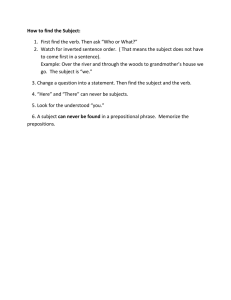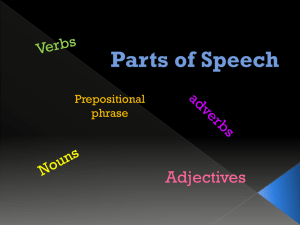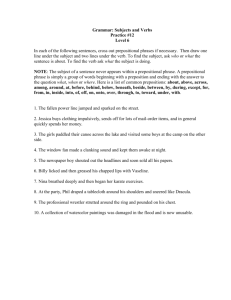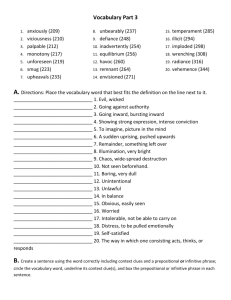Common Paper Errors.doc
advertisement
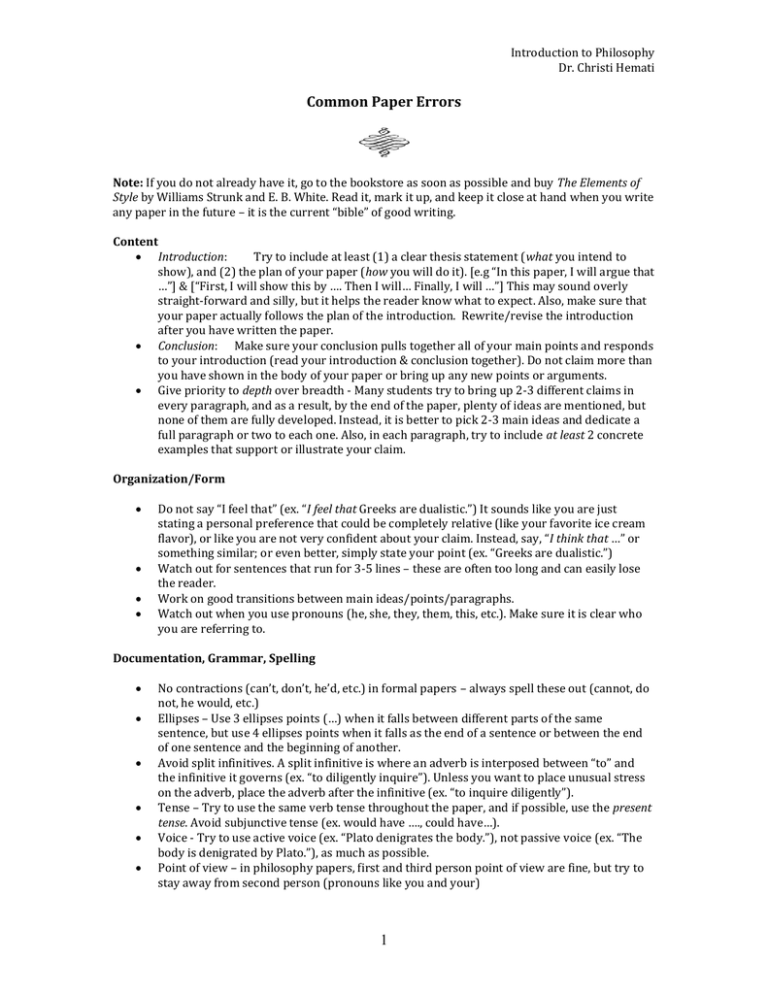
Introduction to Philosophy Dr. Christi Hemati Common Paper Errors Note: If you do not already have it, go to the bookstore as soon as possible and buy The Elements of Style by Williams Strunk and E. B. White. Read it, mark it up, and keep it close at hand when you write any paper in the future – it is the current “bible” of good writing. Content Introduction: Try to include at least (1) a clear thesis statement (what you intend to show), and (2) the plan of your paper (how you will do it). [e.g “In this paper, I will argue that …”] & [“First, I will show this by …. Then I will… Finally, I will …”] This may sound overly straight-forward and silly, but it helps the reader know what to expect. Also, make sure that your paper actually follows the plan of the introduction. Rewrite/revise the introduction after you have written the paper. Conclusion: Make sure your conclusion pulls together all of your main points and responds to your introduction (read your introduction & conclusion together). Do not claim more than you have shown in the body of your paper or bring up any new points or arguments. Give priority to depth over breadth - Many students try to bring up 2-3 different claims in every paragraph, and as a result, by the end of the paper, plenty of ideas are mentioned, but none of them are fully developed. Instead, it is better to pick 2-3 main ideas and dedicate a full paragraph or two to each one. Also, in each paragraph, try to include at least 2 concrete examples that support or illustrate your claim. Organization/Form Do not say “I feel that” (ex. “I feel that Greeks are dualistic.”) It sounds like you are just stating a personal preference that could be completely relative (like your favorite ice cream flavor), or like you are not very confident about your claim. Instead, say, “I think that …” or something similar; or even better, simply state your point (ex. “Greeks are dualistic.”) Watch out for sentences that run for 3-5 lines – these are often too long and can easily lose the reader. Work on good transitions between main ideas/points/paragraphs. Watch out when you use pronouns (he, she, they, them, this, etc.). Make sure it is clear who you are referring to. Documentation, Grammar, Spelling No contractions (can’t, don’t, he’d, etc.) in formal papers – always spell these out (cannot, do not, he would, etc.) Ellipses – Use 3 ellipses points (…) when it falls between different parts of the same sentence, but use 4 ellipses points when it falls as the end of a sentence or between the end of one sentence and the beginning of another. Avoid split infinitives. A split infinitive is where an adverb is interposed between “to” and the infinitive it governs (ex. “to diligently inquire”). Unless you want to place unusual stress on the adverb, place the adverb after the infinitive (ex. “to inquire diligently”). Tense – Try to use the same verb tense throughout the paper, and if possible, use the present tense. Avoid subjunctive tense (ex. would have …., could have…). Voice - Try to use active voice (ex. “Plato denigrates the body.”), not passive voice (ex. “The body is denigrated by Plato.”), as much as possible. Point of view – in philosophy papers, first and third person point of view are fine, but try to stay away from second person (pronouns like you and your) 1 Introduction to Philosophy Dr. Christi Hemati The word “this” should have a noun following it whenever possible. Articulating the subject of your sentence will make your writing more precise. This practice dramatically improves philosophical writing which tends toward the abstract. Avoid forms of the verb “to be” wherever possible. Forms of the verb “to be” are: is are, was, were, would be, should be. Decide what the subject of your sentence actually does and chose the active verb that best conveys that particular action. Once you make these changes, “to be” constructions actually become points of emphasis. Again, this practice diminishes the needlessly abstract dimensions of philosophical writing. Avoid long strings of prepositional phrases. A preposition is a word like: at, about around, over, against, of, through, etc. A preposition conveys a spatial or temporal relationship to something. Pay particular attention to strings of “ofs” and “ins.” Try not to use more than one, or at most two, prepositional phrases in a row. Using shorter sentences and active verbs diminishes the dependence on prepositional constructions. Clear and concise - Avoid expletives like: There are, It is, It is possible that, It seems likely that. Notice the difference between saying “It is possible to banish them completely.” and “Banish them completely.” Say what you think. Be emphatic. o Avoid the overuse of weasel words. Weasel words are terms like: seems to be, appears to be, might actually be, somehow, in some way, could possibly be the case. Again, say what you think. Be emphatic. o Omit needless words. Replace the phrase “in order to do X” with “to do X.” Try to put statements in positive form. Make definite assertions and avoid tame, colorless, hesitating, noncommittal language. Use the word not as a means of denial, never as a means of evasion (ex. “He was not very often on time.” versus “He usually came late.”) which vs. that – That is the defining, or restrictive, pronoun, which the nondefining, or nonrestrictive. The easiest mistake is to use “which” when you should actually use “that” – usually, if you can use either one, use “that” and you’re safe. Example of proper use: o “that” – The lawn mower that is broken is in the garage. (Tells which one.) o “which” – The lawn mower, which is broken, is in the garage. (Adds a fact about the only mower in question.) If you bring in outside information, cite your resource. Also, make sure your resource is authoritative or reliable. Writing Process Write the paper first without worrying much about these guidelines. Once you finish writing, go through the paper line by line and make these changes. It may take 1-2 hours to revise, but don’t be dismayed by the tedium of the process. You will be amazed at the difference. You may even find that your ideas improve. Sometimes, when I get “blocked,” I sit down and start making these changes. Inevitably, I become “unblocked.” 2
